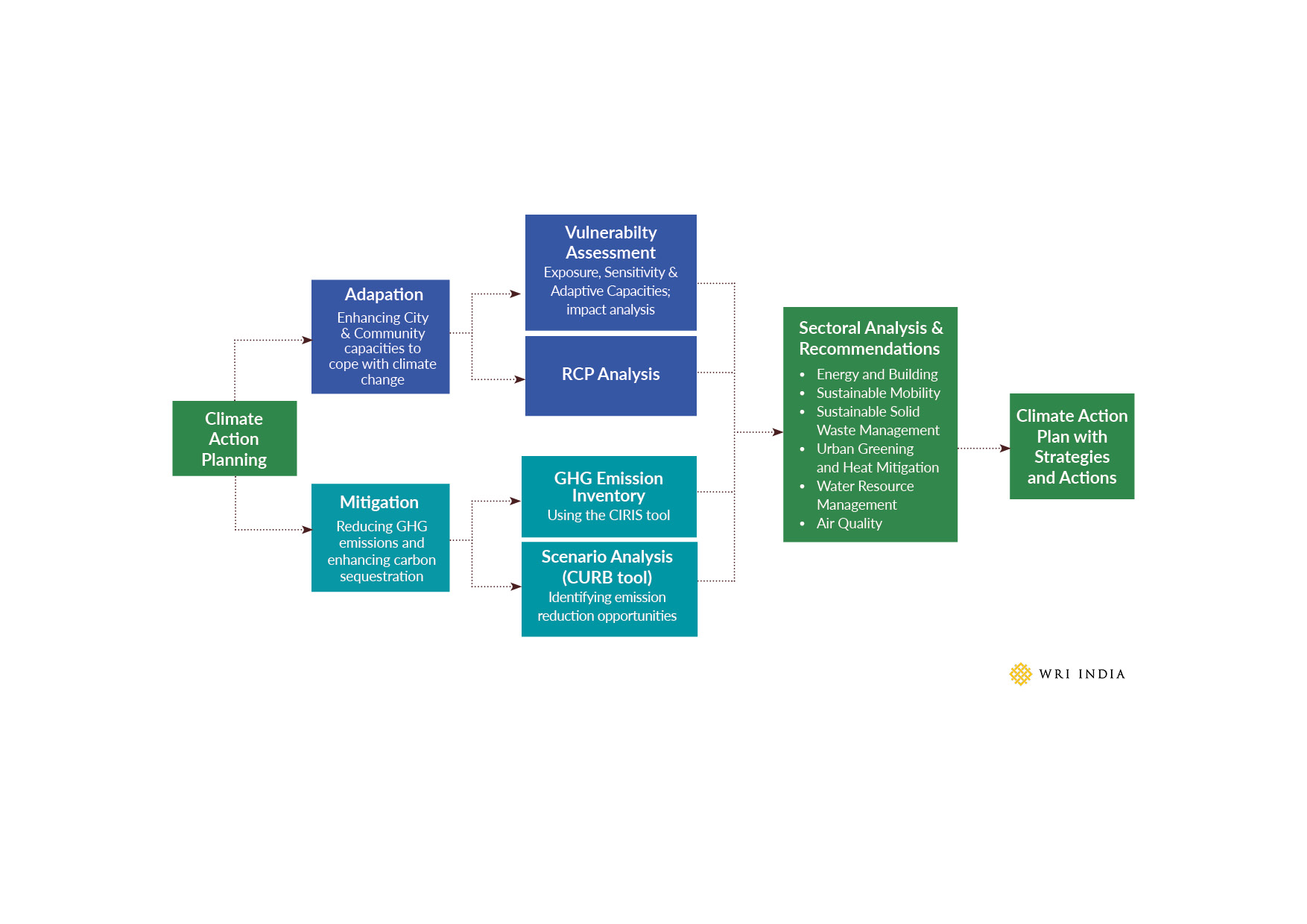
Small Cities, Big Impact: Scaling up Climate Action Planning across Maharashtra
This is the first blog in a three-part series that presents the climate action planning process – from creation of the plan to its implementation – for three cities in Maharashtra. It records the learnings from this process and looks at how climate action plans can pave the way for sustainable, equitable and resilient development.
As India aspires to become a $35 trillion economy by 2047, our urban centres will be at the heart of this growth story. While metropolitan cities contribute the most to the nation’s wealth, smaller cities are rapidly growing both in terms of population and their economy. As this urban expansion unfolds, the demands for housing, infrastructure and services will only rise, exacerbating vulnerability to climate risks.
Maharashtra ranks among the world’s 50 regions at risk for climate-related damage to its infrastructure and built environment. Nearly 75% of the state’s urban population resides in 43 of its AMRUT cities. These cities face mounting climate risks such as extreme heat, erratic monsoons, rising sea levels, flooding, droughts, deteriorating air quality and increased greenhouse gas emissions.
To grow and sustain its ongoing economic transformation, Maharashtra’s cities need resilient infrastructure, services and amenities. The responsibility for providing these largely lies with the respective city municipal bodies. Although statutory master plans exist, cities in the state are increasingly developing cross-sectoral climate action plans to tackle climate challenges from both the resilience and emission reduction perspectives.
This blog aims to encapsulate WRI India’s learnings and challenges from the process of providing technical support for developing climate action plans for three cities in Maharashtra – Nashik, Chhatrapati Sambhajinagar and Solapur. These learning can help inform other AMRUT cities as they plan to scale up their climate action efforts.
Setting a Precedent with the Mumbai Climate Action Plan
Launched in 2021, the Mumbai Climate Action Plan (MCAP) marks Mumbai as the first city in South Asia to align with the Paris Agreement. The MCAP focuses on reducing emissions and enhancing climate resilience through both adaptation and mitigation strategies. The MCAP has set a precedent for smaller cities across Maharashtra, inspiring them to develop their respective climate action plans tailored to their unique environmental and urban challenges.
Scaling Up Climate Action for Mid-Size Cities
Recognizing the unique challenges smaller cities face, Maharashtra has selected three key urban centres — Nashik, Chhatrapati Sambhajinagar and Solapur — to scale up climate action planning. These cities, each with their own geographic and economic characteristics, are also part of India’s Smart Cities Mission and have committed to achieving net-zero carbon emissions by 2050 through the United Nations Framework Convention on Climate Change (UNFCCC) ’s Race to Zero campaign.
The three cities offer unique economic and ecological potential. Nashik, for instance, is known for its growing IT sector. Solapur has a rich history in textiles, while Chhatrapati Sambhajinagar is becoming an auto-industrial hub. Their ecological assets range from the biodiversity of Nashik’s Godavari River to the Himayat Bagh (garden) in Chhatrapati Sambhajinagar and Solapur’s grassland ecosystem. As these smaller cities grow in population, so does citizens’ exposure to rising greenhouse gas (GHG) emissions and heightened climate risks. To achieve systemic urban growth in these cities, a climate action plan can offer the framework to manage urban expansion while aligning with the Paris Agreement’s goal of limiting global warming to 1.5 degrees centigrade.
The Climate Action Planning Process
Developing a climate action plan (CAP) is an integrated process rooted in urban planning, governance, and the socioeconomic and political context of the region. Guided by data-driven decisions, inclusivity and action-oriented strategies, the CAP is based on two key pillars –
- Adaptation: Strengthening the capacity of cities and communities to cope with current and future climate risks.
- Mitigation: Reducing GHG emissions to achieve net-zero goals and combat climate change.
The process of developing a climate action plan begins with the city’s adaptive capacity and mitigation potential assessment and baseline assessments— which include vulnerability assessments and GHG emissions inventories — to establish comprehensive climate profiles. These profiles, informed by data on climate risks and emissions, help identify high-risk areas and major emission sources. Building on these assessments, Scenario and Representative Concentration Pathway (RCP) analyses are then used to project future GHG emission concentrations and climate risks for the identified vulnerable communities.
In the case of the Climate Action Plans for Nashik, Chhatrapati Sambhajinagar and Solapur, the findings helped identify six priority sectors - energy, transportation, waste management, urban greening, water resources and air quality – based on which actions and strategies were developed. Despite challenges, such as data gaps, varying capacities among city officials, limited inter-departmental coordination and working across administrative boundaries, WRI India’s efforts in these cities focused on creating a cohesive approach to urban climate action.
At each stage, stakeholder consultations helped in data validation and aligning actions with local needs. The action steps were then refined based on collective input. Finally, the strategies were synthesized into detailed sectoral actions, responsibilities assigned to relevant agencies and potential funding sources were identified. With a solid framework for implementation, monitoring and governance, the three CAPs are now ready for implementation.

As Indian cities continue to drive the country’s economic growth, Maharashtra’s proactive adoption of climate action plans sets a powerful example. The Government of Maharashtra’s recent Government Resolution (GR) on establishing Climate Action Cells in cities, districts and divisions mandates every region to develop its own CAP. Scaling up these efforts is essential – CAPs must evolve beyond traditional urban planning and become dynamic, living documents, embedding climate action by prioritizing strategies across all forms of urban development.
The next blog in the series will detail out techniques to prioritize climate action in vulnerable areas with support from urban governance structures.